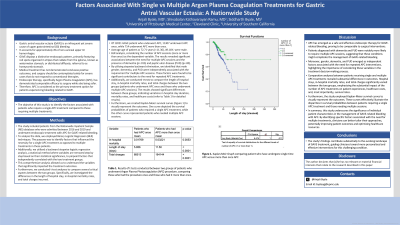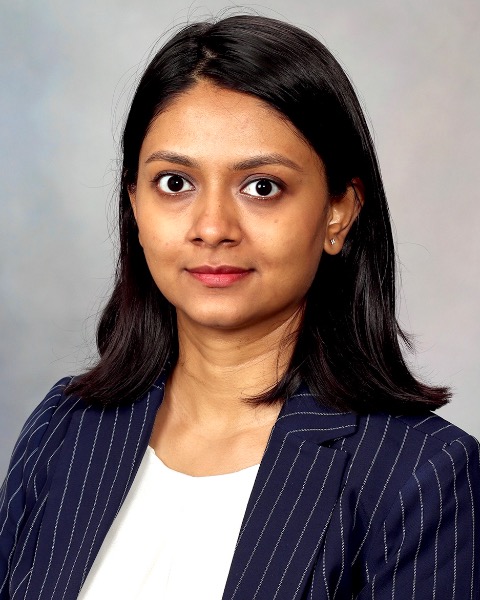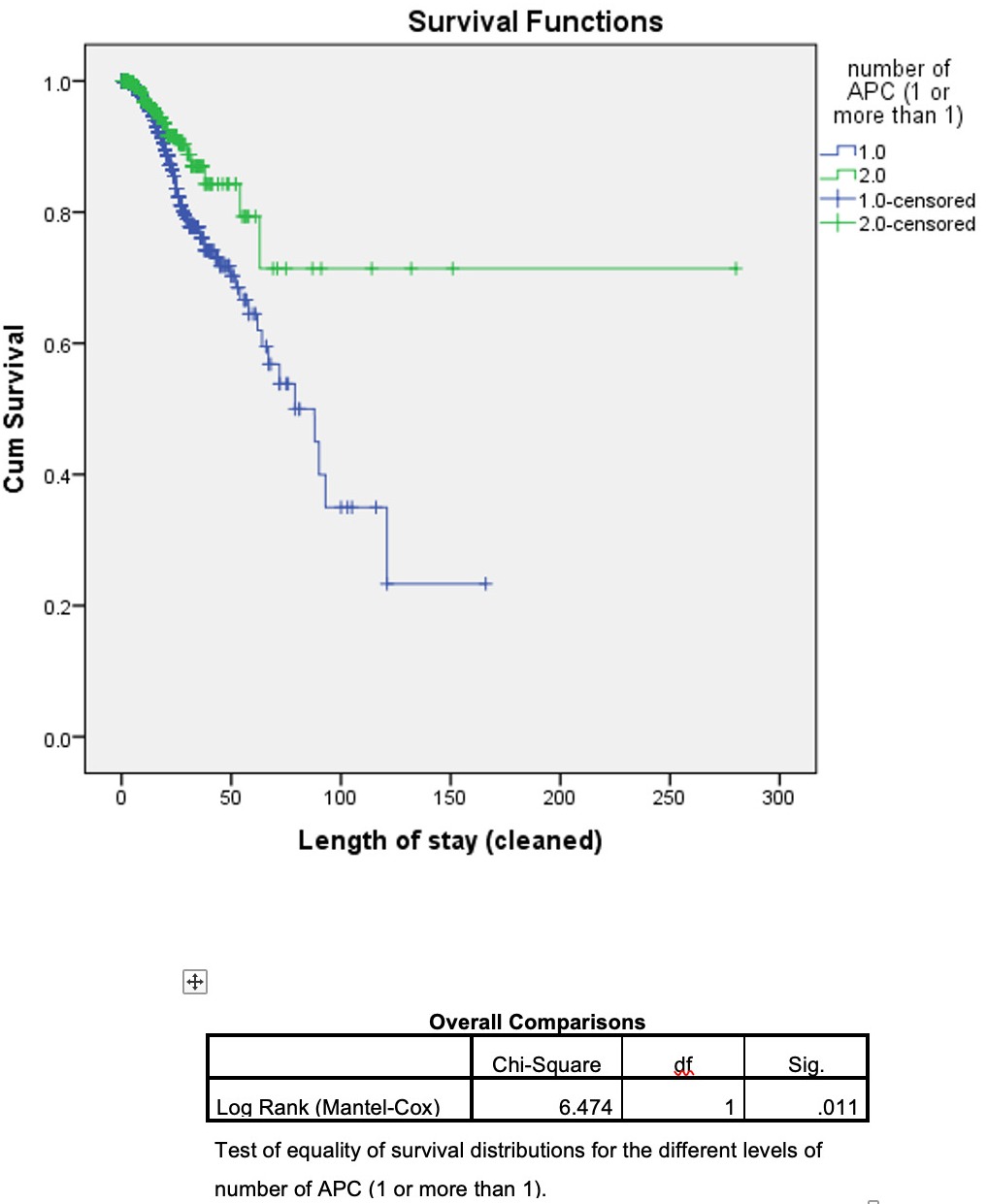Monday Poster Session
Category: GI Bleeding
P2029 - Factors Associated With Single vs Multiple Argon Plasma Coagulation Treatments for Gastric Antral Vascular Ectasia: A Nationwide Study
Monday, October 23, 2023
10:30 AM - 4:15 PM PT
Location: Exhibit Hall


Anjali Byale, MD
University of Pittsburgh Medical Center
Pittsburgh, PA
Presenting Author(s)
Shivabalan Kathavarayan Ramu, MD1, Anjali Byale, MD2
1Cleveland Clinic, Cleveland, OH; 2University of Pittsburgh Medical Center, Pittsburgh, PA
Introduction: Gastric antral vascular ectasia (GAVE) is an infrequent yet severe cause of upper gastrointestinal (GI) bleeding, accounting for approximately 4% of non-variceal upper GI hemorrhages. Endoscopic therapy, specifically Argon Plasma Coagulation (APC), has demonstrated comparable efficacy to surgery while also being safer. Therefore, APC should be considered as the primary treatment option for patients experiencing bleeding related to GAVE. The objective of this study is to identify the factors associated with patients who require a single APC treatment compared to those requiring multiple treatments.
Methods: The study included all patients from the Nationwide Inpatient Sample (NIS) database who were admitted between 2016-19 and underwent endoscopic treatment with APC for GAVE-related bleeding. Binary logistic regression (BLR) analysis was conducted to identify factors associated with the need for a single APC treatment compared to multiple treatments. Additionally, backward stepwise logistic regression analysis was performed to identify factors independently associated with the 2 groups. To compare the length of hospital stay, in-hospital mortality, and total charges between the two groups, t-test analysis was conducted.
Results: Of 12021 GAVE patient who underwent APC, 11307 underwent APC once, while 714 underwent APC more than once. Average age of patient as 72.71 years (±11.36), 49.14 were male. BLR with number of times APC (once or more than once) as dependent variable showed that presence dementia (p=.015) and peptic ulcer disease (PUD) (p=.00) were significantly associated. With the use of stepwise backward elimination, male gender, dementia, and PUD were independently associated with multiple time APC. A significant t-test results were obtained when compared the length of hospital stay, in-hospital mortality, and total charges between the two groups (Table 1). Furthermore, Kaplan-Meier survival curves were generated, with one curve representing patients requiring a single APC treatment and the other curve representing patients requiring multiple APC treatments.
Discussion: These results emphasize the importance of considering APC as the primary treatment option for GAVE-related bleeding, particularly in patients with the identified risk factors.

Disclosures:
Shivabalan Kathavarayan Ramu, MD1, Anjali Byale, MD2. P2029 - Factors Associated With Single vs Multiple Argon Plasma Coagulation Treatments for Gastric Antral Vascular Ectasia: A Nationwide Study, ACG 2023 Annual Scientific Meeting Abstracts. Vancouver, BC, Canada: American College of Gastroenterology.
1Cleveland Clinic, Cleveland, OH; 2University of Pittsburgh Medical Center, Pittsburgh, PA
Introduction: Gastric antral vascular ectasia (GAVE) is an infrequent yet severe cause of upper gastrointestinal (GI) bleeding, accounting for approximately 4% of non-variceal upper GI hemorrhages. Endoscopic therapy, specifically Argon Plasma Coagulation (APC), has demonstrated comparable efficacy to surgery while also being safer. Therefore, APC should be considered as the primary treatment option for patients experiencing bleeding related to GAVE. The objective of this study is to identify the factors associated with patients who require a single APC treatment compared to those requiring multiple treatments.
Methods: The study included all patients from the Nationwide Inpatient Sample (NIS) database who were admitted between 2016-19 and underwent endoscopic treatment with APC for GAVE-related bleeding. Binary logistic regression (BLR) analysis was conducted to identify factors associated with the need for a single APC treatment compared to multiple treatments. Additionally, backward stepwise logistic regression analysis was performed to identify factors independently associated with the 2 groups. To compare the length of hospital stay, in-hospital mortality, and total charges between the two groups, t-test analysis was conducted.
Results: Of 12021 GAVE patient who underwent APC, 11307 underwent APC once, while 714 underwent APC more than once. Average age of patient as 72.71 years (±11.36), 49.14 were male. BLR with number of times APC (once or more than once) as dependent variable showed that presence dementia (p=.015) and peptic ulcer disease (PUD) (p=.00) were significantly associated. With the use of stepwise backward elimination, male gender, dementia, and PUD were independently associated with multiple time APC. A significant t-test results were obtained when compared the length of hospital stay, in-hospital mortality, and total charges between the two groups (Table 1). Furthermore, Kaplan-Meier survival curves were generated, with one curve representing patients requiring a single APC treatment and the other curve representing patients requiring multiple APC treatments.
Discussion: These results emphasize the importance of considering APC as the primary treatment option for GAVE-related bleeding, particularly in patients with the identified risk factors.

Figure: Kaplan-Meir Graph comparing patient who have undergone single time APC versus more than once APC
Disclosures:
Shivabalan Kathavarayan Ramu indicated no relevant financial relationships.
Anjali Byale indicated no relevant financial relationships.
Shivabalan Kathavarayan Ramu, MD1, Anjali Byale, MD2. P2029 - Factors Associated With Single vs Multiple Argon Plasma Coagulation Treatments for Gastric Antral Vascular Ectasia: A Nationwide Study, ACG 2023 Annual Scientific Meeting Abstracts. Vancouver, BC, Canada: American College of Gastroenterology.
